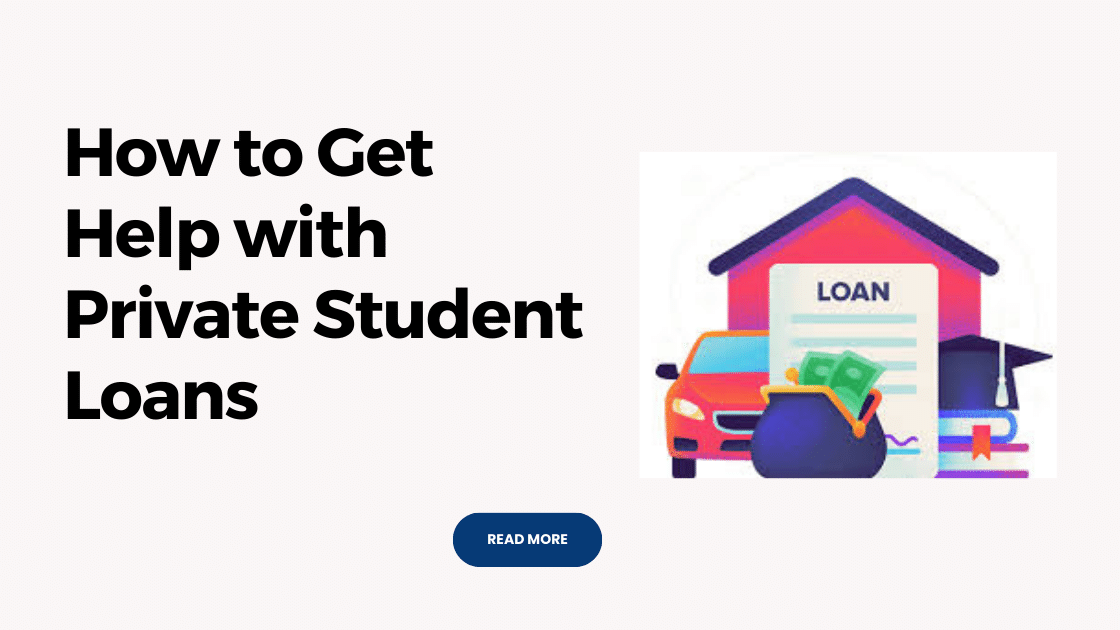How to Get Help with Private Student Loans: The rising burden of private student loans Private student loans have become a significant burden for many borrowers, with increasing tuition costs and limited financial aid options. It is essential for borrowers to seek help and assistance to navigate the complexities of managing private student loans effectively.
If you have any questions About How to Get Help with Private Student Loans Article you can ask us from the comment section given below.
How to Get Help with Private Student Loans

Understanding Private Student Loans | How to Get Help with Private Student Loans
What are private student loans?
- Private student loans are educational loans provided by private financial institutions, such as banks or credit unions, to students and their families.
- These loans are not backed by the government, unlike federal student loans.
Key differences from federal student loans
- Unlike federal student loans, private student loans typically have higher interest rates.
- Repayment terms for private student loans may vary, often being less flexible than federal loan options.
- Private student loans may not offer the same borrower benefits, such as deferment or forbearance, as federal loans.
Interest rates, repayment terms, and other considerations
- Private student loan interest rates vary depending on several factors, such as the borrower’s credit score and the current market rates.
- Repayment terms for private student loans generally range from 5 to 20 years.
- Borrowers should carefully consider the terms and conditions of private student loans before committing to them.
Assessing Your Private Student Loan Situation | How to Get Help with Private Student Loans
Evaluating loan amount, interest rates, and repayment options
- Begin by understanding the total amount of your private student loan debt.
- Consider the interest rates attached to each loan and assess if refinancing or consolidation may be beneficial.
- Explore various repayment options available for your private student loans.
Understanding your financial capabilities and constraints
- Evaluate your current financial situation by assessing your income, expenses, and other financial obligations.
- Understand your budgetary constraints and determine how much you can allocate towards your private student loan repayments.
Identifying potential repayment challenges
- Anticipate any financial challenges you may face during your loan repayment journey, such as job instability or unexpected expenses.
- By identifying potential challenges, you can seek help and be better prepared to overcome them.
Exploring Repayment Options | How to Get Help with Private Student Loans
a. Standard Repayment Plans
- Overview and eligibility requirements
- Standard repayment plans for private student loans typically involve fixed monthly payments over a specified repayment period.
- Eligibility requirements may vary based on the lender, but generally, borrowers must have a good credit history and meet certain income criteria.
- Pros and cons
- Pros: Regular, predictable payments allow borrowers to build financial stability and pay off their loans in a timely manner.
- Cons: Monthly payments may be higher compared to other repayment options, making it challenging for some borrowers to manage their cash flow.
- How to apply and qualify
- Contact your loan servicer to inquire about standard repayment plans and understand the application process.
- Qualification may involve providing your financial information, credit history, and meeting specific lender requirements.
b. Income-Driven Repayment Plans (IDR)
- Overview and eligibility requirements
- Income-Driven Repayment plans are designed to make loan repayment more manageable for borrowers with limited income.
- Eligibility requirements may include demonstrating a financial need and having a qualifying loan type.
- Different IDR plans: Income-Based Repayment (IBR), Pay As You Earn (PAYE), Revised Pay As You Earn (REPAYE)
- IBR: Monthly payments are based on income and family size, and loan forgiveness may be available after a certain period of repayment.
- PAYE: Similar to IBR, but with more generous terms for eligible borrowers.
- REPAYE: Offers loan forgiveness after 20 or 25 years of repayment, regardless of income.
- Calculating monthly payments based on income
- IDR plans calculate monthly payments based on a percentage of your discretionary income, usually around 10-20%.
- Applying and enrolling in an IDR plan
- Contact your loan servicer to initiate the application process.
- Provide the necessary financial documentation to determine your eligibility for an IDR plan.
- Recertifying income and handling plan renewals
- IDR plans require borrowers to recertify their income annually to ensure accurate payment calculations.
- Stay proactive and comply with recertification requirements to avoid any disruptions in your repayment plan.
Refinancing and Consolidating Private Student Loans
a. Understanding Loan Refinancing and Consolidation
- Differences between refinancing and consolidation
- Refinancing involves replacing one or more existing loans with a new loan that typically offers better terms, such as lower interest rates or a longer repayment period.
- Consolidation, on the other hand, combines multiple loans into a single loan, simplifying repayment.
- Benefits and drawbacks
- Benefits: Refinancing or consolidation can potentially lower interest rates, reduce monthly payments, and simplify loan management.
- Drawbacks: Some borrowers may lose certain federal loan benefits, such as loan forgiveness or income-driven repayment options, when refinancing or consolidating private student loans.
b. Finding the Right Refinancing Lender
- Comparing interest rates and repayment terms
- Research and compare interest rates and repayment terms offered by different refinancing lenders.
- Consider factors such as fixed or variable interest rates, repayment period, and any potential fees.
- Assessing additional borrower benefits
- Look for lenders that offer borrower benefits, such as interest rate reductions for on-time payments or cosigner release options.
- Factors to consider before refinancing
- Examine your credit score and financial stability to determine if refinancing is a viable option.
- Consider the potential impact on your overall financial goals, such as buying a house or saving for retirement.
c. Step-by-step guide to refinancing or consolidation
- Preparing documents and financial information
- Gather necessary documents, such as loan statements, proof of income, and credit reports, to streamline the application process.
- Applying with a prospective lender
- Follow the lender’s application instructions and submit all required documents.
- Ensure accuracy and completeness of the application to increase the chances of approval.
- Loan approval process and timeline
- Wait for the lender’s response and be prepared to provide additional information if requested.
- The approval process and timeline may vary depending on the lender and individual circumstances.
- Repayment under the new terms
- Once approved, carefully review the new loan terms and repayment details.
- Make timely payments and stay informed about any changes or updates from the refinancing lender.
Negotiating with Private Loan Servicers
Importance of communication and engagement
- Establishing open communication with your private loan servicers can help address concerns and explore potential solutions.
Strategies for negotiation
- Stay calm and professional during negotiations, focusing on finding mutually beneficial solutions.
- Provide supporting documentation or financial hardship evidence to strengthen your negotiation position.
Seeking forbearance, deferment, or loan modification
- If facing temporary financial hardship, inquire about the possibility of forbearance or deferment options.
- Loan modification may be available in certain situations, such as a change in income or unexpected circumstances.
Seeking Assistance from Non-Profit Organizations
Overview of non-profit organizations offering student loan assistance
- Several non-profit organizations provide resources and guidance to borrowers struggling with private student loans.
- These organizations offer financial counseling, debt management plans, and educational resources.
Identifying credible and reliable sources of help
- Verify the credibility and reputation of non-profit organizations before seeking assistance.
- Look for organizations affiliated with reputable financial education programs or government agencies.
Obtaining expert guidance and counseling
- Seek guidance from certified student loan counselors who can provide personalized advice tailored to your specific situation.
- These counselors can help explore various repayment options and guide you towards financial stability.
Government Resources for Private Student Loan Borrowers
Available resources from the U.S. Department of Education
- The U.S. Department of Education provides information and resources for borrowers with private student loans.
- Explore their website for guidance on repayment options and loan forgiveness programs.
National Student Loan Data System (NSLDS) for loan information
- Access the NSLDS to view your federal loan information, such as loan balances and loan servicer contact details.
- Although it primarily focuses on federal loans, it can still provide a comprehensive overview of your student loan status.
Accessing federal repayment options and loan forgiveness programs
- In some cases, borrowers may be eligible for federal loan options, such as income-driven repayment plans or loan forgiveness programs.
- Explore the eligibility criteria and requirements for these programs for potential assistance.
Private Student Loan Bankruptcy Discharge
Understanding the criteria for student loan bankruptcy discharge
- Private student loans are generally not dischargeable in bankruptcy, except in cases of “undue hardship.”
- To determine if your private student loans meet the “undue hardship” criteria, consult with a bankruptcy attorney.
Establishing undue hardship for private student loans
- In most bankruptcy cases, borrowers must demonstrate that repaying their private student loans would cause them severe financial distress.
- The “undue hardship” standard can be challenging to meet and often requires legal expertise.
Legal considerations and potential challenges
- Each bankruptcy case is unique, and the outcome depends on various factors, including state laws and the specific circumstances of the borrower.
- Consult with a knowledgeable attorney to navigate the legal complexities and potential challenges of discharging private student loans.
How to Get Help with Private Student Loans Summary
Common scam tactics targeting borrowers Watch out for warning signs, such as requests for payment via wire transfer, pressure to make quick decisions, and unprofessional or misleading websites. Tips for safeguarding personal and financial information Protect your personal and financial information by using secure websites, monitoring your credit report, and being vigilant against potential scams. Consider freezing your credit to prevent unauthorized access.
Thank You For Reading How to Get Help with Private Student Loans Article ,If you have any questions About How to Get Help with Private Student Loans Article you can ask us from the comment section given below.
FAQs For How to Get Help with Private Student Loans
1 . Can private student loans be forgiven like federal student loans?
- Private student loans generally do not offer the same forgiveness options as federal loans. However, some lenders may provide limited forgiveness programs in specific situations.
2 . Can I transfer my private student loans to federal loans?
- Private student loans cannot be directly transferred to federal loans. However, refinancing or consolidation with a private lender may allow you to transition from private to federal loan status.
3 . Are there income-based repayment options for private student loans?
- Income-based repayment options are generally not available for private student loans. However, some private lenders may offer alternative repayment plans based on income.
4 . Should I prioritize loan refinancing or consolidation?
- Prioritizing loan refinancing or consolidation depends on your specific financial goals and circumstances. Consider factors such as interest rates, loan terms, and potential benefits or drawbacks before making a decision.
5 . Are non-profit organizations providing assistance legitimate?
- Non-profit organizations can provide valuable assistance, but it is crucial to verify their credibility and reputation before seeking their services. Look for organizations affiliated with established financial education programs or government agencies.
Also Read:
What to Do About Private Student Loans


Pingback: Does American Express Do Auto Loans? Understanding Your Financing Choices 2023 | Read Now - ShapeZap